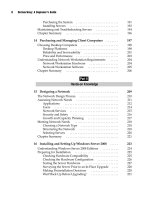Networking: A Beginner’s Guide Fifth Edition- P26 pdf
Bạn đang xem bản rút gọn của tài liệu. Xem và tải ngay bản đầy đủ của tài liệu tại đây (148.48 KB, 5 trang )
107
Chapter 8: Understanding Networking Protocols
complex Windows–based network that also uses TCP/IP, however, the NetBIOS names
resolve to TCP/IP addresses through the use of Windows Internet Name Service
(WINS). The names can also be resolved using static name definition entries contained
in a file called LMHOSTS (for LAN Manager HOSTS).
Because some networking applications still use NetBIOS Names, either WINS or
LMHOSTS allows such applications to continue to function in a TCP/IP-only network.
As far as the application is concerned, it is still working with NetBIOS, while TCP/IP
performs the actual work in the background.
AppleTalk
AppleTalk has been extended into AppleTalk Phase 2, which now allows routing of
AppleTalk packets (assuming an AppleTalk Phase 2-capable router). The Phase 2
variant can run over Ethernet, Token Ring, or Apple’s LocalTalk media. Under Ethernet,
AppleTalk uses a variant of the 802.2 frame type called Ethernet Subnetwork Access
Point (SNAP).
AppleTalk has an important history for Apple Macintosh networking, but Apple
now fully supports and recommends TCP/IP for its computers.
Chapter Summary
This chapter is built on the knowledge you gained in earlier chapters, delving into
various important protocols involved in virtually all networks, including the Internet.
You learned primarily about the TCP/IP protocol, which has essentially displaced
older protocols such as IPX/SPX and NetBIOS/NetBEUI (although these older
protocols are still used). You also learned about some specific application-layer Internet
protocols, such as SMTP, DHCP, and HTTP. These are all vital protocols to understand
for any networking professional.
It would be nice if the protocols discussed in this chapter were all you had to contend
with, but, unfortunately, many more protocols exist. Some are specific to certain functions,
such as remote access to a network, and are discussed in appropriate chapters within
this book. Others are still being developed and are not a factor now, but may be in the
near future. You will certainly want to stay up-to-date with emerging protocols that may
become important to networking.
The next chapter is about directory services, which make complex networks easier
to use and administer.
This page intentionally left blank
109
Chapter 9
Exploring Directory
Services
110
Networking: A Beginner’s Guide
I
n the early days of local area networks (LANs), finding server resources was simple.
Most organizations started with just a file server and a print server or two, so
knowing which files, printers, and other services were in which locations on the
LAN was easy.
These days, the situation is considerably more complex. Even relatively small
organizations might have multiple servers, all performing different jobs—storing
different sets of files and providing different Internet or intranet services, such as e-mail
servers, web hosting, database servers, network services, and so forth.
Directory services work to bring organization to this far-flung network clutter. In
this chapter, you learn about what directory services do and how they work. You also
learn about the directory services in use today and those slated for use in the near
future. With directory services becoming more and more central to the administration
of networks, learning this information becomes an increasingly important part of
designing, deploying, and managing networks.
What Is a Directory Service?
In most networks, you optimize the function of different services by hosting them on
different computers. Doing so makes sense. Putting all your services on one computer
is a bit like placing all your eggs in one basket—if you drop the basket, you’ll break
all your eggs. Moreover, you can achieve optimal performance, more reliability, and
higher security by segregating network services in various ways.
Most networks have quite a few services that need to be provided, and often these
services run on different servers. Even a relatively simple network now offers the
following services:
N File storage and sharing
N Printer sharing
N E-mail services
N Web hosting, both for the Internet and an intranet
N Database server services
N Specific application servers
N Internet connectivity
N Dial-in and dial-out services
N Fax services
N Domain Name System (DNS) service, Windows Internet Naming Service
(WINS), and Dynamic Host Configuration Protocol (DHCP) services
N Centralized virus-detection services
N Backup and restore services
111
Chapter 9: Exploring Directory Services
This is only a short list. Larger organizations have multiple servers sharing in each
of these functions—with different services available through different means in each
building or location—and might have additional services beyond those listed here.
All this complexity can quickly make a network chaotic to manage. If each one of
the individual servers required separate administration (with, for instance, separate
lists of users, passwords, groups, printers, network configurations, and so on), the job
would become virtually impossible in no time.
Directory services were invented to bring organization to networks. Basically,
directory services work just like a phone book. Instead of using a name to look up
an address and phone number in a phone book, you query the directory service for
a service name (such as the name of a network folder or a printer), and the directory
service tells you where the service is located. You can also query directory services
by property. For instance, if you query the directory service for all items that are
“printers,” it can return a complete list, no matter where the printers are located in the
organization. Even better, directory services enable you to browse all the resources on a
network easily, in one unified list organized in a tree structure.
One important advantage of directory services is that they eliminate the need to
manage duplicates of anything on the network because the directory is automatically
shared among all of the servers. For example, you don’t need to maintain separate user
lists on each server. Instead, you manage a single set of user accounts that exists in the
directory service and then assign them various permissions to particular resources on
any of the servers. Other resources work the same way and become centrally managed
in the directory service. Not only does this mean that you have only one collection of
objects to manage, but also that users have a much simpler network experience. From
the users’ perspective, they have only one network account with one password, and
they don’t need to worry about where resources are located or keep track of multiple
passwords for different network services or servers.
NOTE In this chapter, the term network resource refers to any discrete resource on a network,
such as a user account, security group definition, e-mail distribution list, storage volume, folder, or
file. The term directory refers to the directory that a directory service uses, rather than a directory on
a hard disk.
To provide redundancy, directory services usually run on multiple servers in an
organization, with each of the servers having a complete copy of the entire directory
service database. Because a directory service becomes central to the functioning of a
network, this approach lets the network as a whole continue to operate if any single
server with directory services on it crashes. Servers that do not actually host a copy
of the directory still make use of it by communicating with the directory servers. For
instance, if a user tries to open a file hosted on a server that doesn’t actually host the
directory service, the server will automatically query the directory service on another
server to authenticate the user’s access request. To the user, this happens behind
the scenes.









